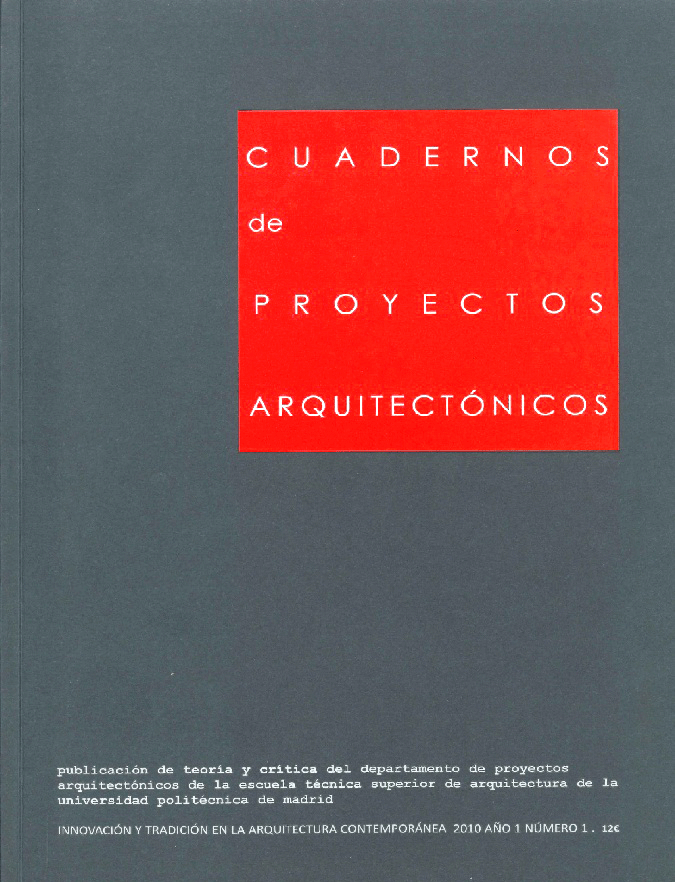Presentación
Abstract
¿ Is it perhaps the right time to outline the cultural frame from which we can obtain a critical reflection about contemporary architecture? What seems more appropriate at this moment of continuous transformations and alterations in architecture is that the possibility of communicating and effectively transmitting knowledge can only occur under conditions having the greatest heterodoxy. The aim is thus to transfer the focus from what happens to what can come out of uncertain links or interactions not previously programmed between those points of view and other actions relating to architecture. The dissolution of limits, categories, or references (professional or strategic) has ended up configuring a dilated scene that ranges from unforeseen chance to empirical pragmatism. This scene becomes extremely fertile terrain for all these exciting interactions to take form. It is on that stimulating platform of ambiguity where "Cuadernos de Proyectos Arquitectónicos" invites us to take a seat and establish different points of view from which we can derive multiple conclusions and point out plural, alternative and provocative interpretations. This new publication emerges as a university re-action from the Madrid School of Architecture, through the Departamento de Proyectos Arquitectónicos; and, in particular, it emerges out of the will and energy of some individuals, as well as their intellectual generosity, to once again establish scenes of agreement, contrast and opportunity, from which dialogue, thinking and critical reflection can be generated. Out of those initial approaches we can ask further questions, such as: "What interpretations can be extracted from this publication?", or "What possible readings can we make and what kind of expectations could we derive from the coexistence by chance of the following names-individuals?. ¿ Is it adequate to do it based on the interaction of times and occurrences that are neither linear nor simultaneous, and even apparently contradictory, and thus review the most recent modernity and the expectations for the future of Architecture? ¿ls it viable for these new interlaced, confusing, ambiguous, immanent thinking strategies based on the crisis of order to generate new ways of approximating architectural action? It becomes evident that this is not the moment to answer the preceding questions, nor the many others that can come up. However this new magazine emerges as a great opportunity to make it possible for any of these questions to be raised; and what is even more important, to generate the chance to link them together in a deliberately wider, freer and more open thinking structure. This action of inciting reflection and critique coming from a careful selection of articles, subjects and authors is without a doubt one of the unavoidable and necessary responsibilities of a truly educational institution. In the Information Age, the traditional management and dissemination of culture coming out of the university has been transformed into other forms of interaction directed at much more selective and precise genres of knowledge. One of the most appreciated abilities in Architecture no longer consists of knowing how to select that which is essential but rather knowing how to establish or imagine unusual, surprising, different connections out of multiple variables. In such an academic context, where both theoretical and practical research becomes urgent, the Administration of the Architectural Projects Department of the Madrid School of Architecture, on behalf of all its teachers, celebrates and enthusiastically supports the initiative of creating this publication, hoping that it will serve as an effective bond for thinking and stimulus in the context and actions f Architecture. Best of luck.
Downloads
Dowloads
Pubblicato
Fascicolo
Sezione
Licenza
1. Los autores conservan los derechos de autor y garantizan a la revista el derecho de una Licencia Creative Commons Atribución-NoComercial-SinDerivar 4.0 Internacional que permite a otros compartir el trabajo con un reconocimiento de la autoría.
2. Los autores pueden establecer por separado acuerdos adicionales para la distribución no exclusiva de la versión de la obra publicada en la revista (por ejemplo, situarlo en un repositorio institucional o publicarlo en un libro).












